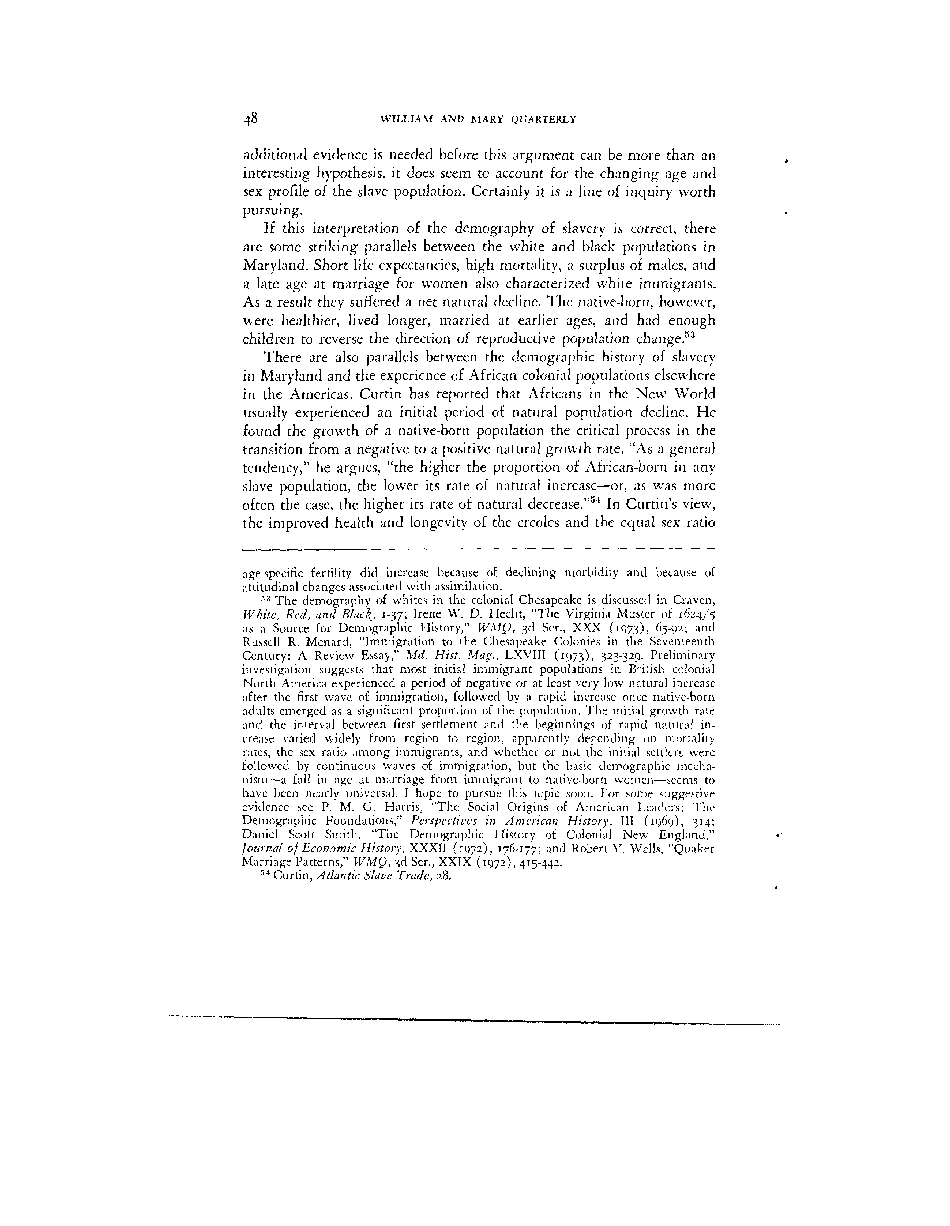|
48 WILLIAM AND MARY QUARTERLY
additional evidence is needed before this argument can be more than an
interesting hypothesis, it does seem to account for the changing age and
sex profile of the slave population. Certainly it is a line of inquiry worth
pursuing.
If this interpretation of the demography of slavery is correct, there
are some striking parallels between the white and black populations in
Maryland. Short life expectancies, high mortality, a surplus of males, and
a late age at marriage for women also characterized white immigrants.
As a result they suffered a net natural decline. The native-born, however,
were healthier, lived longer, married at earlier ages, and had enough
children to reverse the direction of reproductive population change.53
There are also parallels between the demographic history of slavery
in Maryland and the experience of African colonial populations elsewhere
in the Americas. Curtin has reported that Africans in the New World
usually experienced an initial period of natural population decline. He
found the growth of a native-born population the critical process in the
transition from a negative to a positive natural growth rate. "As a general
tendency," he argues, "the higher the proportion of African-born in any
slave population, the lower its rate of natural increase—or, as was more
often the case, the higher its rate of natural decrease."54 In Curtin's view,
the improved health and longevity of the Creoles and the equal sex ratio
age-specific fertility did increase because of declining morbidity and because of
attitudinal changes associated with assimilation.
53 The demography of whites in the colonial Chesapeake is discussed in Craven,
White, Red, and Elac\, 1-37; Irene W. D. Hecht, "The Virginia Muster of 1624/5
as a Source for Demographic History," WMQ, 3d Ser., XXX (1973), 65-92; and
Russell R. Menard, "Immigration to the Chesapeake Colonies in the Seventeenth
Century: A Review Essay," Md. Hist. Mag., LXVIII (1973), 323-329. Preliminary
investigation suggests that most initial immigrant populations in British colonial
North America experienced a period of negative or at least very low natural increase
after the first wave of immigration, followed by a rapid increase once native-born
adults emerged as a significant proportion of the population. The initial growth rate
and the interval between first settlement and the beginnings of rapid natural in-
crease varied widely from region to region, apparently depending on mortality
rates, the sex ratio among immigrants, and whether or not the initial settlers were
followed by continuous waves of immigration, but the basic demographic mecha-
nism—a fall in age at marriage from immigrant to native-born women—seems to
have been nearly universal. I hope to pursue this topic soon. For some suggestive
evidence see P. M. G. Harris, "The Social Origins of American Leaders: The
Demographic Foundations," Perspectives in American History, III (1969), 314;
Daniel Scott Smith, "The Demographic History of Colonial New England,"
Journal of Economic History, XXXII (1972), 176-177; and Robert V. Wells, "Quaker
Marriage Patterns," WMQ, 3d Ser., XXIX (1972), 415-442.
54 Curtin, Atlantic Slave Trade, 28.
�
|

